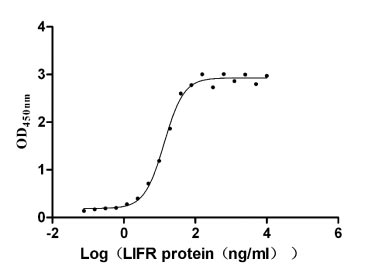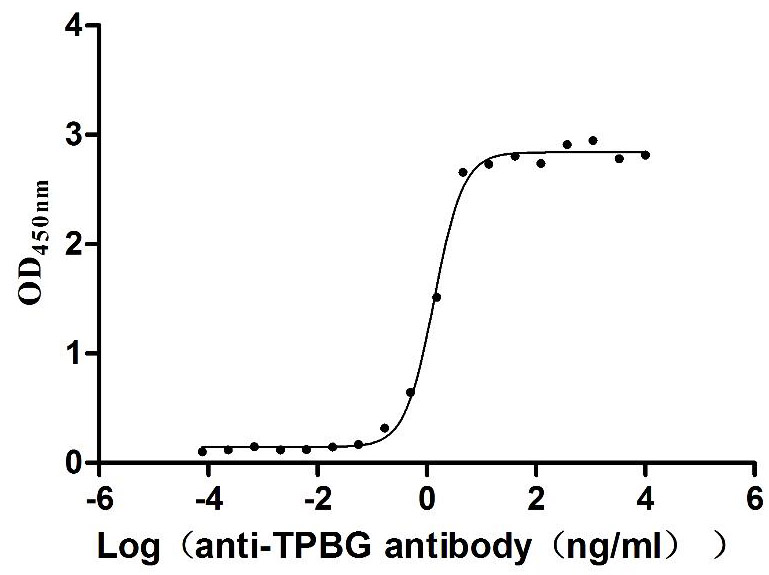Recombinant Arabidopsis thaliana Protein EARLY FLOWERING 3 (ELF3), partial
-
中文名稱:擬南芥ELF3重組蛋白
-
貨號:CSB-YP526880DOA
-
規(guī)格:
-
來源:Yeast
-
其他:
-
中文名稱:擬南芥ELF3重組蛋白
-
貨號:CSB-EP526880DOA
-
規(guī)格:
-
來源:E.coli
-
其他:
-
中文名稱:擬南芥ELF3重組蛋白
-
貨號:CSB-EP526880DOA-B
-
規(guī)格:
-
來源:E.coli
-
共軛:Avi-tag Biotinylated
E. coli biotin ligase (BirA) is highly specific in covalently attaching biotin to the 15 amino acid AviTag peptide. This recombinant protein was biotinylated in vivo by AviTag-BirA technology, which method is BriA catalyzes amide linkage between the biotin and the specific lysine of the AviTag.
-
其他:
-
中文名稱:擬南芥ELF3重組蛋白
-
貨號:CSB-BP526880DOA
-
規(guī)格:
-
來源:Baculovirus
-
其他:
-
中文名稱:擬南芥ELF3重組蛋白
-
貨號:CSB-MP526880DOA
-
規(guī)格:
-
來源:Mammalian cell
-
其他:
產(chǎn)品詳情
-
純度:>85% (SDS-PAGE)
-
基因名:
-
Uniprot No.:
-
別名:ELF3; PYK20; At2g25930; F17H15.25; T19L18.26Protein EARLY FLOWERING 3; Nematode-responsive protein
-
種屬:Arabidopsis thaliana (Mouse-ear cress)
-
蛋白長度:Partial
-
蛋白標簽:Tag?type?will?be?determined?during?the?manufacturing?process.
The tag type will be determined during production process. If you have specified tag type, please tell us and we will develop the specified tag preferentially. -
產(chǎn)品提供形式:Lyophilized powder
Note: We will preferentially ship the format that we have in stock, however, if you have any special requirement for the format, please remark your requirement when placing the order, we will prepare according to your demand. -
復溶:We recommend that this vial be briefly centrifuged prior to opening to bring the contents to the bottom. Please reconstitute protein in deionized sterile water to a concentration of 0.1-1.0 mg/mL.We recommend to add 5-50% of glycerol (final concentration) and aliquot for long-term storage at -20℃/-80℃. Our default final concentration of glycerol is 50%. Customers could use it as reference.
-
儲存條件:Store at -20°C/-80°C upon receipt, aliquoting is necessary for mutiple use. Avoid repeated freeze-thaw cycles.
-
保質期:The shelf life is related to many factors, storage state, buffer ingredients, storage temperature and the stability of the protein itself.
Generally, the shelf life of liquid form is 6 months at -20°C/-80°C. The shelf life of lyophilized form is 12 months at -20°C/-80°C. -
貨期:Delivery time may differ from different purchasing way or location, please kindly consult your local distributors for specific delivery time.Note: All of our proteins are default shipped with normal blue ice packs, if you request to ship with dry ice, please communicate with us in advance and extra fees will be charged.
-
注意事項:Repeated freezing and thawing is not recommended. Store working aliquots at 4°C for up to one week.
-
Datasheet :Please contact us to get it.
靶點詳情
-
功能:May be a transcription factor part of a circadian clock input pathway. Acts within a 'zeitnehmer' feedback loop and is involved in its own circadian regulation. Has no role in regulating circadian clock function in the dark. Part of a corepressor complex consisting of ELF4, ELF3, and LUX involved in the transcriptional regulation of APRR9. The activity of the protein may be decreased in long day conditions due to its interaction with phytochrome B (phyB). Can regulate the initiation of flowering independently of phyB. Also involved in responses to nematode parasitism, like the formation of the nematode feeding structure.
-
基因功能參考文獻:
- Based on our results, the authors propose that ELF3 modulates key regulatory components in salt stress response pathways at the transcriptional and post-translational levels. PMID: 29032592
- PIF4 and ELF3 have roles in Arabidopsis thermoresponsive flowering PMID: 27564448
- Data identified proteins that associate with the evening complex composed of EARLY FLOWERING 4 (ELF4), EARLY FLOWERING 3 (ELF3), and LUX ARRHYTHMO (LUX). PMID: 26545401
- Data show that natural variation in EARLY FLOWERING3 (ELF3) controls the link between root constraint and altered shoot growth. This PMID: 26243313
- This work establishes the role of ELF3 in the ambient temperature signaling network. Natural variation of ELF3-mediated gating of PIF4 expression during nightly growing periods seems to be affected by a coding sequence quantitative trait nucleotide. PMID: 26269119
- The Transcriptional Regulator BBX19 Promotes Hypocotyl Growth by Facilitating COP1-Mediated EARLY FLOWERING3 Degradation in Arabidopsis PMID: 25841036
- The transcriptional regulator EARLY FLOWERING3 (ELF3) controls elongation growth in response to temperature. High temperature relieves the gating of growth at night, highlighting the importance of temperature-dependent repressors of growth. PMID: 25557663
- This study shows that ELF3 and PIF4 proteins interact in an EC-independent manner, and that this interaction prevents PIF4 from activating its transcriptional targets. It also shows that PIF4 overexpression leads to ELF3 protein destabilization. PMID: 25557667
- allele originated in Central Asia; Collectively, we showed that ELF3 protein plays a vital role in defining its light-repressor action in the circadian clock and its functional abilities are largely dependent on its cellular localization PMID: 24867215
- The evening loop of the circadian clock is represented by ELF3 and ELF4. PMID: 24267177
- The phenotypic consequences of natural variation in the polyQ tract encoded by EARLY FLOWERING 3 (ELF3), was investigated. PMID: 23129635
- The ELF4 recognition site of ELF3 is required for sustaining circadian rhythm. ELF3 and ELF4 directly repress the morning clock gene PPR9. PMID: 22327739
- show that CCA1 represses ELF3 by associating with its promoter, completing a CCA1-ELF3 negative feedback loop that places ELF3 within the oscillator PMID: 22190341
- The mutant elf3-12 is attenuated in its capacity for repressive light input signaling to the circadian clock while maintaining its capacity to sustain oscillator function. PMID: 21908721
- The results define a new cell-autonomous role for FT and demonstrate that the flowering time genes ELF3 and FT are involved in the regulation of H(+)-ATPase by blue light in guard cells. PMID: 21737277
- sel20, suppressor of elf3, was a new deletion allele of a mutation in the blue light receptor, CRY2. PMID: 21296763
- identification of a protein complex composed of the proteins encoded by EARLY FLOWERING 3 (ELF3), ELF4 and the transcription-factor-encoding gene LUX ARRHYTHMO (LUX; also known as PHYTOCLOCK 1)--that directly regulates plant growth PMID: 21753751
- The mechanism of action of ELF3 in the activation and repression of the circadian clock is reported. PMID: 21236675
- ELF3 is proposed as a component of the shade avoidance signalling pathway. PMID: 20713464
- ELF3 has been implicated in the shade avoidance response and different natural alleles of this gene are shown to have phenotypic effects. PMID: 20838594
- ELF3 is broadly required for circadian clock function regardless of light conditions. PMID: 20133619
- The function of ELF3 and ELF4 in their light-regulated expression associated with CCA1, LHY, and TOC1 as part of the central oscillator of the circadian clock in Arabidopsis is reported. PMID: 16212608
- We show that the effects of ZTL and ELF3 on circadian clock function and early photomorphogenesis are additive. PMID: 16258016
- ELF3 acts as a substrate adaptor, enabling COP1 to modulate light input signal to the circadian clock through targeted destabilization of GI. PMID: 19061637
- Ambient temperature regulates flowering by two genetic pathways: one that is closely associated with the photoperiod pathway and requires ELF3, and another that requires TFL1 and is related to the autonomous pathway. PMID: 19187043
顯示更多
收起更多
-
亞細胞定位:Nucleus.
-
數(shù)據(jù)庫鏈接:
Most popular with customers
-
Recombinant Human Leukemia inhibitory factor receptor (LIFR), partial (Active)
Express system: Mammalian cell
Species: Homo sapiens (Human)
-
Recombinant Human HLA class II histocompatibility antigen gamma chain (CD74), partial (Active)
Express system: Mammalian cell
Species: Homo sapiens (Human)
-
Recombinant Human Interleukin-17A (IL17A) (T26A) (Active)
Express system: Baculovirus
Species: Homo sapiens (Human)
-
Recombinant Human Trophoblast glycoprotein (TPBG), partial (Active)
Express system: Mammalian cell
Species: Homo sapiens (Human)
-
Recombinant Human Oncostatin-M (OSM), partial (Active)
Express system: Mammalian cell
Species: Homo sapiens (Human)



-AC1.jpg)
-AC1.jpg)












